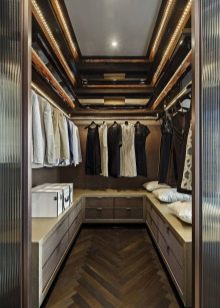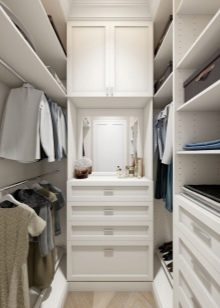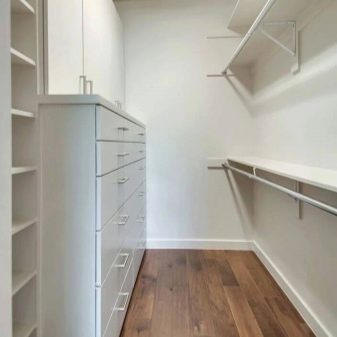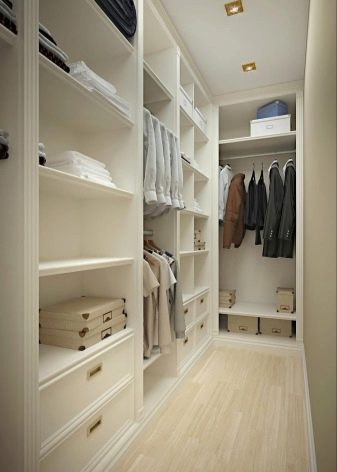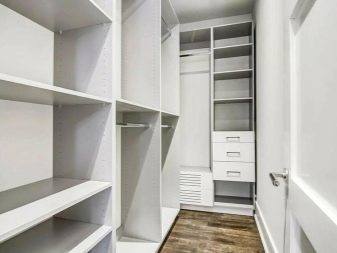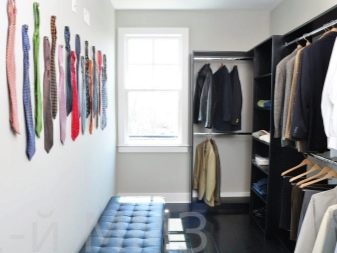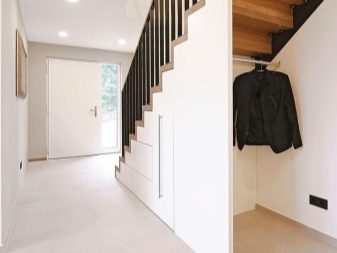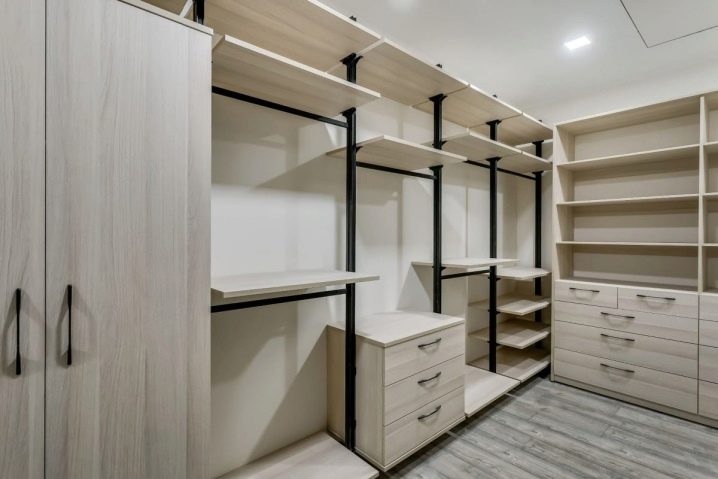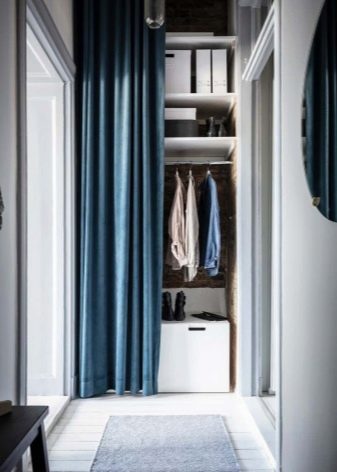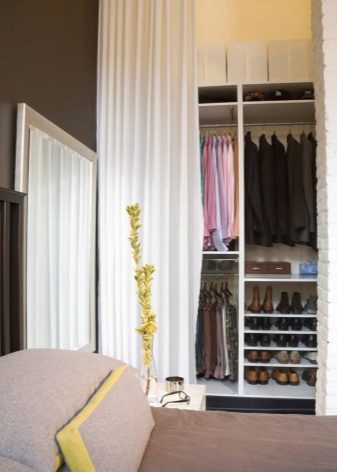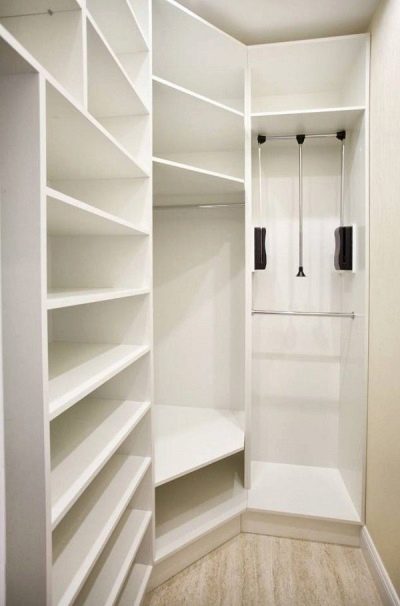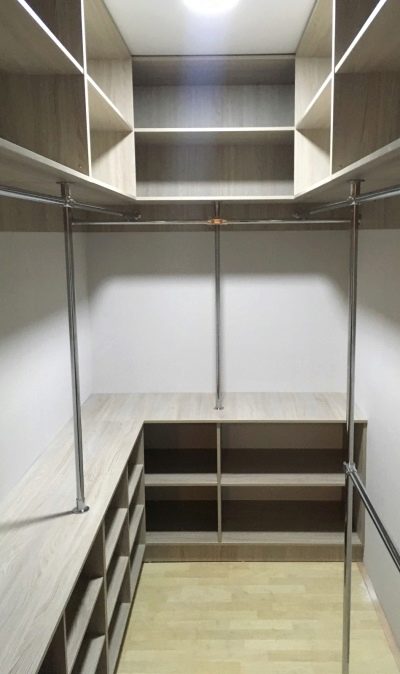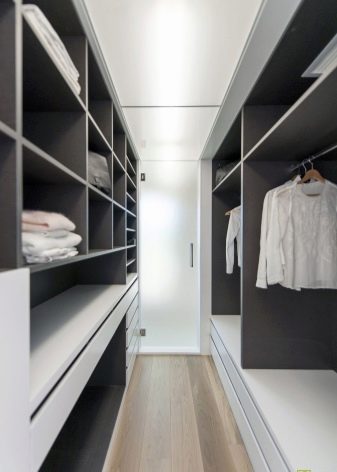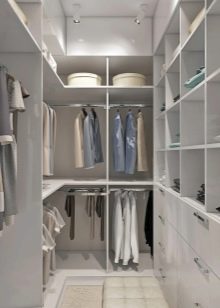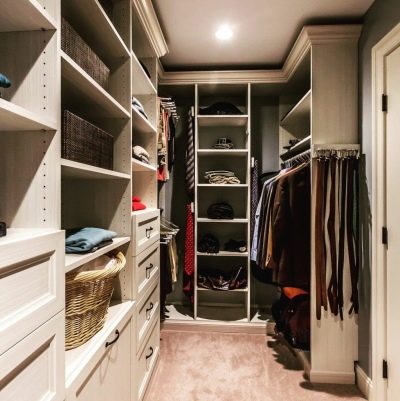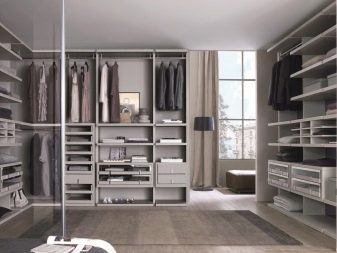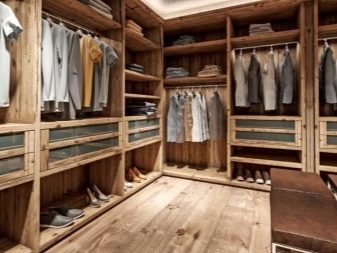All about narrow dressing rooms

Dressing room is a great alternative to wardrobes and dressers. It not only solves the pressing issues of storage, but also allows you to free living space from unnecessary furniture.
Peculiarities
A walk-in closet is a small room where you can store clothes, shoes, various household items and accessories, such as bed linen. It is convenient not only to keep a daily wardrobe, seasonal outerwear, toilets, fancy dress in it, but also to hide a vacuum cleaner, for example. In fact, this is a small room, more like a closet, but used on a daily basis.
It can be of various sizes, be an independent room or a fenced-off section of a living room. And while the narrow walk-in closet looks more like a built-in wardrobe, it has more functional storage systems, such as shelves under the ceiling.
Even a fenced long strip of limited area can hold more than a regular wardrobe.
A walk-in closet allows you to free your living space from unnecessary furniture. Everything that can be stored in cabinets and dressers is transferred to it. At the same time, it becomes more spacious not only in the bedroom or living room, you can unload the hallway, nursery and even a balcony.
Where to place?
The easiest way to equip a dressing room is in a separate small room or closet. There is a ready-made room, which remains to be filled with various storage systems, and to carry out lighting.
As an option, you can arrange a dressing room in the attic. The room often has a low ceiling, which is sloped in places due to the overhangs of the roof. All this limits the functionality of the room. To equip such a space, most likely, you will need to purchase custom-made furniture.
A great option for small apartments is to arrange a dressing room on the balcony. This room is rarely used, so you can successfully beat it. In this case, it is important to take into account the presence of direct sunlight, under which the fabric burns out. For this, closed storage systems are used, which additionally protect against dust, or a darkening film for glass. The room itself must be insulated and sealed so that moisture from precipitation does not get inside and condensation does not accumulate.
In a private two-story house, you can hide a dressing room under the stairs. This space is seldom used and can be equipped profitably.
Alternatively, the dressing room can be located in the basement, but it will be inconvenient to use it. Such a room is more suitable for a classic pantry.
If there is no separate room for the dressing room, then it can be fenced off with a screen, curtains or a false wall in the living room or bedroom. But the size of the resulting "room" should be at least 1.5-1.7 square meters. m. Less is simply impractical, it will already be a built-in wardrobe. You can fence off an entire wall or corner. Perhaps there are niches, corridor dead ends or nooks. They can also be converted into dressing rooms.
Layout
To make the most of every centimeter of space, you need to think over the layout in advance. It strongly depends on the size of the future dressing room and the needs of the owners. For example, if the family is large, you might think about tiered systems and lots of shelves.
There are three types of layouts for dressing rooms:
-
linear;
- corner;
- U-shaped.
The linear layout provides for the location of storage systems along the wall, and is preferable for narrow walk-in closets. The shelves can be located on one wall or touch the side ones (in the shape of the letter L or P).
Corner layout is suitable for small corner rooms. All storage systems are located on two adjacent walls.
U-shaped layout is suitable for more spacious rooms. Often this is a separate room or a former narrow but more spacious storage room. Storage systems are located on two opposite sides. For example, on one side of the dressing room there are bars and shelves for clothes, and on the other - shelves for storing bed linen and other household utensils.
How to fill?
For wardrobe equipment, storage systems are most often made to order. It takes into account not only the size of the room and the layout, but the personal wishes of the residents. For example, the top shelves can be made large for storing seasonal outdoor clothing and shoes, as they are less likely to be taken out than everyday ones. Or instead of one hanger bar, you might need two or three.
Storage systems typically include:
-
open and closed shelves;
-
drawers;
-
hanger bars;
-
hanging baskets;
-
small drawers for storing small items.
If the room is narrow, it is better to use sliding doors for cabinets - there may not be enough space for hinged ones. The same applies to drawers. Alternatively, you can use baskets or organizers that match the dimensions of the open shelves. They are more mobile, for convenience you can completely pull them out.
You definitely need to think about lighting. It can be ceiling, point or backlighting. Fits perfectly into the dressing room mirror. If there is nowhere to place it, you can hang it on the front door. An interesting option is to make the sliding doors completely glass. At the same time, it will visually expand the room.
If space permits, the dressing room can be supplemented with an ottoman, dressing table.
Registration
The dressing room, although associated with a pantry, can have its own design style. For example, the high-tech style is characterized by the presence of metal chrome elements, silver and gray shades, a minimum of jewelry. If the storage systems are made of a metal profile, you can beat them in this design.
The country style is characterized by a light ceiling, a wooden floor, walls with a simple pattern in the form of a strip or a cage, plant or animal ornament, imitation of stone are suitable. Storage systems should be made of wood, MDF or chipboard, a simple, discreet form, non-chrome-plated hangers and rods.
The loft style is perfect for a dressing room. Walls should resemble brickwork, open storage systems more reminiscent of storage racks.
Of course, the more spacious the dressing room, the more possibilities for decoration. But even for a narrow room, you can use ready-made ideas or develop your own design project. But the first place should always be the functionality of the room.

